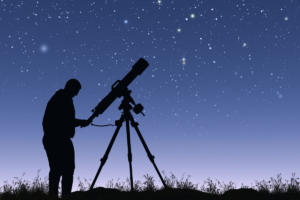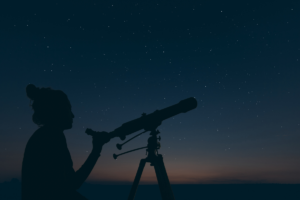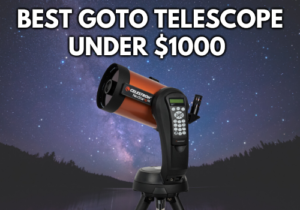Best Camera & Smartphone Adapters For Telescopes 2025
Disclosure: This post contains affiliate links and I may earn a small commission (at no extra cost to you) if you click through and make a purchase. Thanks in advance – I really appreciate it!
If you’re looking for the best camera or smartphone adapters for telescopes to take beautiful pictures of the night sky, then you have landed on the right page.
Camera adapters are a simple, yet crucial component for optimal astrophotography results. They safely connect an SLR camera to your telescope and can help you achieve the correct back focus for your imaging system.
This ensures that whatever is visible will be captured by the camera.
These adapters can range from T-rings, T-adapters, SLR camera adapters, or even adapters capable of mounting your smartphone to a telescope.
The smartphone adapters are clamped onto the eyepiece of the telescope and they hold your phone in place so that the phone’s camera is located behind the eyepiece.
I have divided this article into two sections:
1) Best Camera Adapters For Telescopes – This section will typically cover the adapters that you may need to fix your DSLR or any other camera to the mount of your telescope.
2) Best Smartphone Adapters For Telescopes – If you’re looking to use your iPhone/Android smartphone to take pictures of the celestial bodies, then you may jump straight to this section.
1. Best Camera Adapters For Telescopes
| Image | Title | Price | Buy |
|---|---|---|---|
 | SVBONY T2 T Ring Adapter and T Adapter | See on Amazon | |
 | Astromania 1.25" Extendable Camera Adapter | See on Amazon | |
 | Starboosa 1.25-inch T Adapter and T2 T Ring Adapter | See on Amazon | |
 | Solomark T T2-Ring for Nikon DSLR SLR Camera Lens Adapter | See on Amazon | |
 | SVBONY SV167 T Adapter for Celestron SCT | See on Amazon |
Product prices and availability are accurate as of the date/time indicated and are subject to change. Any price and availability information displayed on [relevant Amazon Site(s), as applicable] at the time of purchase will apply to the purchase of this product.
Prices pulled from the Amazon Product Advertising API on:2. Best Smartphone Adapters For Telescopes
| Image | Title | Price | Buy |
|---|---|---|---|
 | Celestron - NexYZ DX Kit - 3-Axis Universal Smartphone Adapter | See on Amazon | |
 | Gosky Cell Phone Adapter Mount | See on Amazon | |
 | Celestron 81035 Basic Smartphone Adapter | See on Amazon | |
 | Vankey Cellphone Telescope Adapter Mount | See on Amazon | |
 | Orion SteadyPix EZ Smartphone Photo Adapter | See on Amazon |
Product prices and availability are accurate as of the date/time indicated and are subject to change. Any price and availability information displayed on [relevant Amazon Site(s), as applicable] at the time of purchase will apply to the purchase of this product.
Prices pulled from the Amazon Product Advertising API on:Telescope Camera Adapter Reviews
1. SVBONY T2 T Ring Adapter & T Adapter
- Perfect for Canon EOS and Rebel SLR and DSLR Cameras;Note: it doesnt fit for EOS-M models;connect camera to telescope for direct;prime focus; photography convenient and easily
- Super easy to use;thread t adapter into t ring adapter;then thread the whole mount adapter into cameras to connect to telescope
- Universal t adapter fits all standard 1.25 diameter telescope microscope etc;t ring adapter is compatible for all standard 1.25 lenses of cameras;but not for SV13 spotting scope
Prices pulled from the Amazon Product Advertising API on:
Product prices and availability are accurate as of the date/time indicated and are subject to change. Any price and availability information displayed on [relevant Amazon Site(s), as applicable] at the time of purchase will apply to the purchase of this product.
This versatile and sturdy camera adapter is best for you if you have a Canon EOS, Rebel SLR, or DSLR Cameras.
Its Universal T adapter fits all standard 1.25″ diameter telescopes.
2. Astromania Extendable Camera Adapter
- Zoom projection and focal adapter: The simple way to astrophotography begins with this projection adapter. Use your standard Ploessl or Kellner 1.25-inch eyepieces for beautiful photos of the Moon and planets.
- This easy to use 1.25 Variable Universal Camera Adapter is designed to attach both camera body and telescope together. Compatible for both reflector and refractor telescopes with 1.25 eyepiece holders.
- The 1.25 Variable Universal Camera Adapter is made of black-anodized aluminum, threaded for Standard 1.25inch Astronomy Filters. Projection adapter for 1.25-inch eyepieces of up to 38mm outside diameter, also can be used as a focal adapter with a T2 thread.
- Two adapters in one: The projection and focal adapter consists of two parts - the projection part and the focal adapter. The projection part is used with an eyepiece for achieving a long focal length with small objects,
Prices pulled from the Amazon Product Advertising API on:
Product prices and availability are accurate as of the date/time indicated and are subject to change. Any price and availability information displayed on [relevant Amazon Site(s), as applicable] at the time of purchase will apply to the purchase of this product.

Prakash Chandra
I am a science and technology enthusiast who is curious about emerging concepts in spaceflight, aerospace, and robotics. My passion for astronomy started in my childhood, and my craze for writing started when my works got published in my school's newspaper.
ABOUT US
We are a team of active amateur astronomers, here to help you with all your astronomy and science related needs – this is anything, from reviewing the latest telescopes to be released to talking about gravity and neurons. The Big Bang Optics was started because of our love for astronomy and to help others like us find the best telescope and accessories.
LEGAL DISCLAIMER
The Big Bang Optics is a participant in the Amazon Services LLC Associates Program, an affiliate advertising program designed to provide a means for sites to earn advertising fees by advertising and linking to Amazon.com. The Big Bang Optics also participates in affiliate programs with Clickbank and other sites. The Big Bang Optics is compensated for referring traffic and business to these companies.






